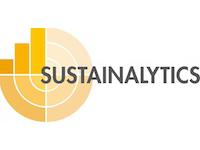What does corporate social responsibility mean in different industries?
What does corporate social responsibility mean in different industries?
Home | Article | List | Video | Methodology | Industry | More from Sustainalytics
“Doing good” means different things in different industries–and our survey spans several. Here’s how researchers at Sustainalytics assessed company performance in the various industry groups:
BANKS | ENERGY AND UTILITIES | FOOD AND BEVERAGE | INDUSTRIALS | MATERIALS | RETAILERS | TECHNOLOGY | TELECOMS/ELECTRONICS | TEXTILES | TRANSPORTATION

BANKS — Personal, commercial, corporate and investment banking
Banks are scrutinized for their lending and investment activities—never more so than in the years after the 2008 financial meltdown in the United States. But banks can use their market power to promote sustainability and discourage involvement in environmentally and socially sensitive commercial activities by applying strong lending and investment standards.
For example: TD Bank Group
TD is a frontrunner amongst Canadian banks, displaying industry-leading environmental innovations. It promotes energy efficiency in its real estate portfolio, for example with its Living Roof. Located on top of its flagship branch in downtown Toronto, its Living Roof not only includes energy efficient features, but also allows rainwater retention and provides an area for vegetation in an urban environment. The innovation complements TD’s two “net-zero” branches in Canada and U.S., which produce as much renewable energy as they use.

ENERGY AND UTILITIES — Oil & gas exploration and production, power generators
This group is a major emitter of greenhouse gases and other air pollutants that contribute to climate change, acid rain and smog. Additionally, there are significant social issues like worker health and safety, bribery and corruption, and community and Aboriginal relations.
For example: Cenovus Energy Inc.
Through its Environmental Opportunity Fund, Cenovus sponsors companies and research groups developing emerging or early-stage technologies that focus on water and energy efficiencies, reducing emissions, environmental remediation, and mitigating land disturbances. Cenovus supports innovative companies like Saltworks Technologies that is converting saltwater to freshwater through solar or waste-heat energy and General Fusion which is developing fusion technology by using hydrogen from seawater to generate affordable, safe and plentiful energy without greenhouse gas emissions, pollution, or radioactive waste.

FOOD AND BEVERAGE — Soft drinks, packaged foods, restaurants
Demand for ethical food options is an important trend in this sector. Product quality, safety and careful management of supply chains are critical issues for companies as they respond to pressure to offer healthier and more sustainable foods.
For example: Danone
Food companies face social and environmental risks across their long, cross-border supply chains. Commodities and ingredients are sourced from international suppliers, which requires proactive supply chain management. Danone developed a calculation system with SAP, an enterprise application software developer, that enables the comparison of environmental impacts throughout the lifecycle of 35,000 products, even if products vary by only a few different ingredients. Danone also audits suppliers for compliance with its social standards, in line with the International Labour Organisation’s Conventions.

INDUSTRIALS — Industrial conglomerates, machinery, aerospace and defence
In this manufacturing-intensive industry, labour relations and employee health and safety are paramount, as is dealing with the environmental impacts associated with manufacturing. Leading companies strive to make their products more energy and fuel efficienct.
For example: Philips Electronics
Recognizing that the majority of energy consumed by its products occurs during usage, not manufacturing, Phillips’ Ecovision5 program aims to improve product energy efficiency, on average, by 50% by 2015. The company’s Green Products line supports this goal. Products in the line offer environmental improvements in at least one of the company’s six Green Focal Areas (energy efficiency, packaging, hazardous substances, weight, recycling and disposal, and lifetime reliability). Philip’s energy saver lights for example offer up to an 80% energy savings from traditional lamps.

MATERIALS — Gold, precious and diversified metals, mining, packaging
Mining inevitably has major environmental impacts. Key issues are how companies in this industry minimize these effects and also address the protection of their workers and affected communities. Gold mining companies face heightened scrutiny over the safe handling and disposal of cyanide, which is widely used in the industry to separate gold from ore.
For example: Cascades Inc.
As part of Cascades commitment to sustainability, the company offers a wide array of green products and services. In addition to its flagship environmental towel and tissue line, the company designs and manufactures garden furniture and public site furnishings (benches, bike racks, trash cans and picnic tables) made of 100% recycled plastic. Cascades also partnered with NextLife, a manufacturer of sustainable plastic resins, to make meat packaging trays out of recycled polystyrene.

RETAILERS — Food, specialty, general merchandise, home improvement
For most retailers, there is nothing more important than the front-line relationship with consumers. A good reputation is invaluable, and how retailers deal with social and environmental issues—like greenhouse gas emissions and waste management—can all have a direct impact on the bottom line.
For example: Gap Inc.
The process of washing and finishing denim requires a significant amount of chemicals, dyes and water. If the wastewater isn’t properly treated, it pollutes rivers and streams and can harm local communities.Through Gap Inc.’s Water Quality Program, the company has developed clear guidelines for the management of toxic chemicals, such as copper and mercury, in wastewater at mills and laundries. Additionally, the company requires that 100% of the denim laundries that manufacture Gap Inc.-branded denim treat the water before it leaves the facility.

TECHNOLOGY — Hardware, software, semiconductors, communications equipment
Recent high-profile controversies surrounding working conditions in China have put labour concerns in this sector in the spotlight. There are also human rights concerns related to so-called conflict minerals sourced by suppliers, and the environmental impacts of electronics throughout their product life cycle. Companies that manage these issues will find themselves with a big advantage.
For example: Intel Corp.
Because semiconductor manufacturing can be water intensive, Intel has a dedicated water policy and invests in conservation technologies. Using water footprint analysis, the company assesses its impact on water resources. Intel established that its most significant impact on water resources is via direct operations and factories, and its second, through its use of energy, known as the “energy-water nexus.” Water equivalency is used to consider the local context at each site to ensure that factors such as aridity and community needs are included when assessing water stress.

TELECOMS/ELECTRONICS — Telephony services, electronic equipment, consumer electronics
Much like the technology sector, social impacts loom large for this group, most importantly the working conditions of employees of contractors and suppliers, and the responsible sourcing of conflict minerals. Notable environmental issues include the development of environmentally friendly electronic products and management of electronic waste. Energy efficient products are also in high demand among consumers.
For example: Panasonic
Panasonic North America (PNA) was named a 2011 Energy Star Partner of the Year where it was recognised for its energy-saving products and environmental outreach to consumers. To strengthen its environmental performance, PNA also announced its commitment to parent company’s “Eco Ideas” strategy – a strategy that focuses on reducing the environmental impact of operations and supporting consumers in leading green lifestyles. As part of its commitment, PNA aims to double its sale of environmentally-conscious products from 2011 to 2013.

TEXTILES, FOOTWEAR & APPAREL — Footwear, sportswear, apparel and accessories
Due to heightened public scrutiny, companies have made progress in addressing child labour and human rights violations within supply chains. However, concerns are still ongoing. Increasingly, so are the environmental impacts of companies with high levels of water use and waste water discharge in their operations. The industry has taken a collaborative approach to address environmental and social risks in supply chains.
For example: Nike
Textile mills use approximately 3 billion gallons of water each year to process cotton and polyester for Nike brand apparel. As part of the Nike Water Program, the company assists its material vendors in addressing water management through its H20*Insight tool. This online data-collection system allows vendors to supply detailed data regarding the processes employed, the materials produced and how much water vendors use and discharge. The data helps Nike assess whether vendors are meeting discharge permits and local environmental standards, as well as Nike’s water quality guidelines.

TRANSPORTATION & LOGISTICS — Shipping, automobiles, railroads
Automakers, the most visible segment of this group, have refocused in recent years on more fuel efficient vehicles. In an era of rising energy costs, consumers have shied away from gas guzzlers. The transportation industry—responsible for a significant portion of global emissions—is also subject to more and more stringent emissions requirements. Union relations are also typically front and centre.
For example: Ford Motor Co.
Rising fuel prices have increased consumer demand for fuel efficient vehicles, while concerns regarding cost and power have prevented much of that demand from transferring into sales. Ford’s EcoBoost engines increase fuel efficiency by approximately 20% and emit 15% fewer CO2 emissions all while maintaining the torque and power of traditional larger engines. The additional cost for the EcoBoost option is approximately USD 1,000, a much more cost effective option than alternative environmentally friendly vehicles. In 2011, 40% of all Ford F-150 sales included the Eco-Boost technology.

